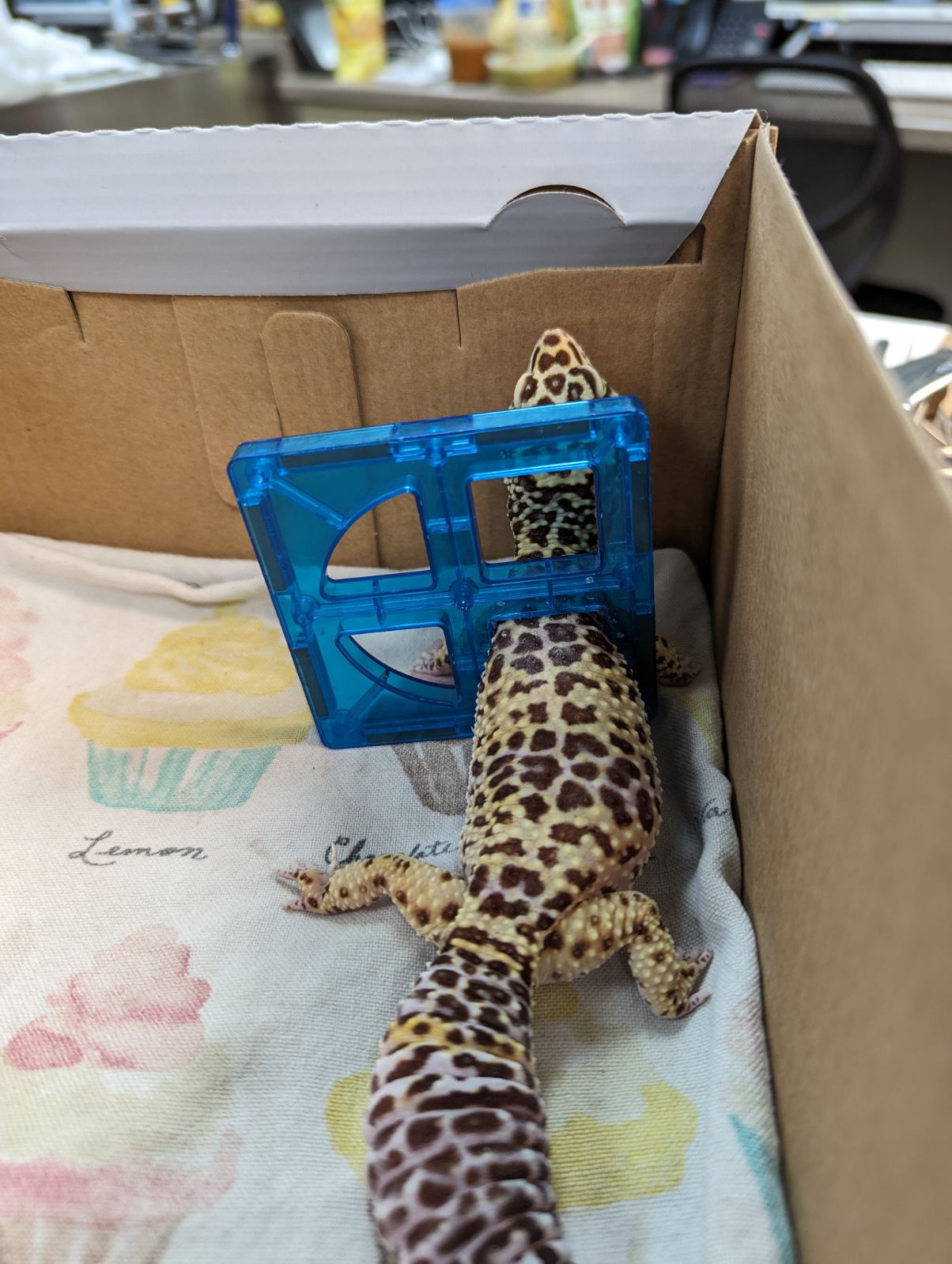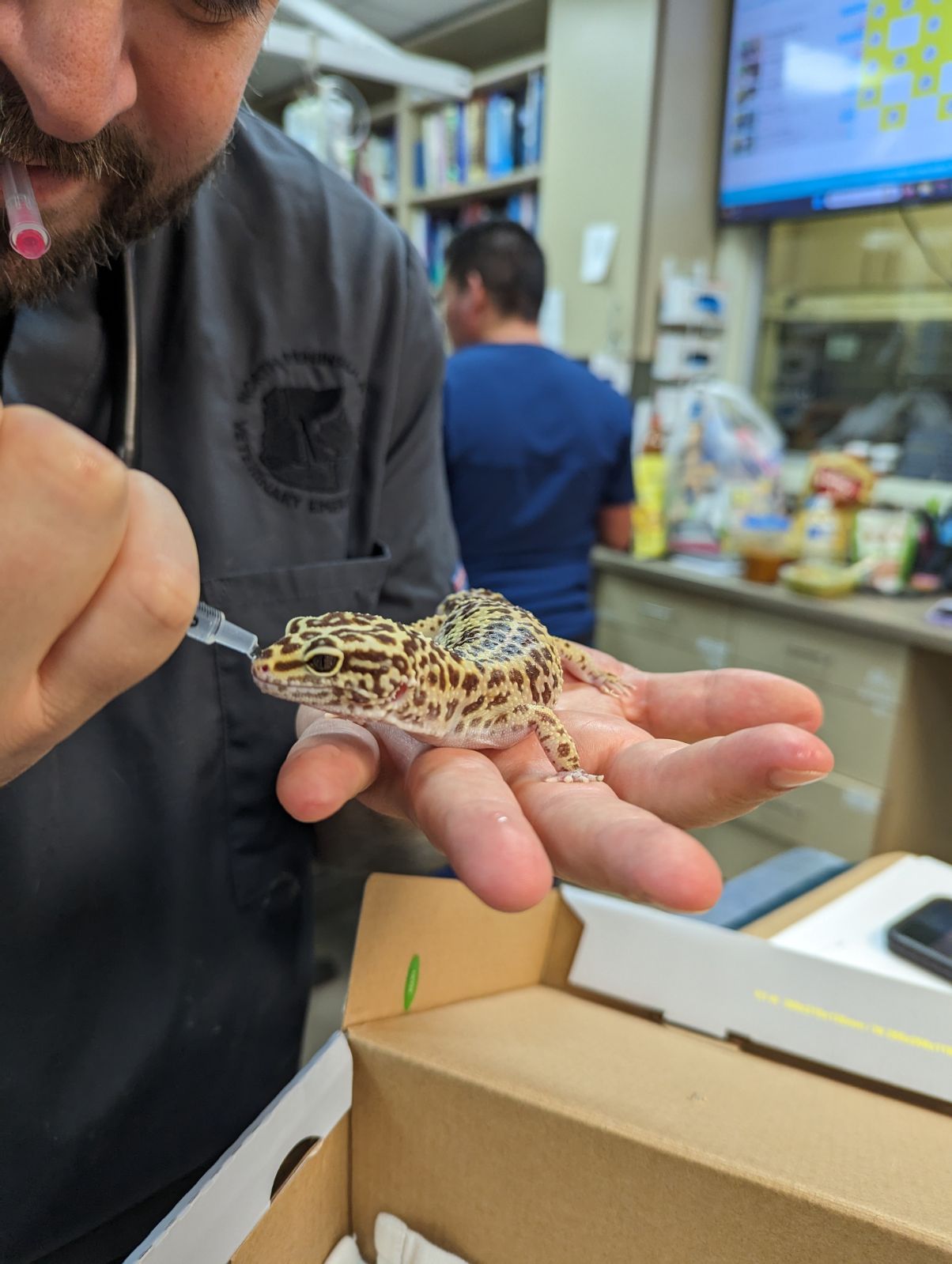YY, a leopard gecko, was exploring the environment in his new home one day when he came across an interesting object. It was located in his new family’s child’s room and had what appeared to be a perfectly lizard-sized opening. He thought perhaps it would lead to a comfy hiding spot and decided to venture further. However, the opening was actually a plastic toy with an opening the size of YY’s head, but not quite big enough for the rest of YY’s body. Before he knew it, he was stuck! YY’s family tried to carefully free their pet gecko from the toy, but he is a gecko after all and was squirming a bit too much. They decided to seek help from a veterinarian to get YY “unstuck.”
 Veterinarians are trained to work with and treat all sorts of animal species, and at North Peninsula Veterinary Emergency Clinic (NPVEC) we do our best to help all creatures, including reptiles! It is unusual to have a gecko patient at the hospital, but luckily for YY’s owners, our new veterinary mentee, Dr. Adam Krantz, was on shift that very night. Dr. Krantz has an extensive background handling a variety of wildlife species and was equal to the task of freeing YY from his tiny toy predicament. During his initial assessment, we learned that YY was given to his current owners by friends who had him for a few years prior. Other than his current issue, YY was healthy overall, eating well, shedding his skin normally, and without any notable medical concerns.
Veterinarians are trained to work with and treat all sorts of animal species, and at North Peninsula Veterinary Emergency Clinic (NPVEC) we do our best to help all creatures, including reptiles! It is unusual to have a gecko patient at the hospital, but luckily for YY’s owners, our new veterinary mentee, Dr. Adam Krantz, was on shift that very night. Dr. Krantz has an extensive background handling a variety of wildlife species and was equal to the task of freeing YY from his tiny toy predicament. During his initial assessment, we learned that YY was given to his current owners by friends who had him for a few years prior. Other than his current issue, YY was healthy overall, eating well, shedding his skin normally, and without any notable medical concerns.
YY was placed on a treatment table where Dr. Krantz was able to gently and safely restrain our squirmy patient. He then used a pair of wire cutters to slowly and carefully snip through the plastic toy. It worked like a charm! Thankfully, YY was not harmed during his adventure and no further treatment was needed.
Geckos are fascinating animals that are found worldwide in a range of environments from deserts to rainforests, except on Antarctica. You may recognize them by their adorable toe-pads with sticky ridges on the undersides. The approximately 1500 species of geckos are a part of the reptile class of vertebrates; early relatives of modern day geckos roamed the earth during the Jurassic Period (recall Jurassic Park, the movie, with all its thrills). They are heterotherms, which means they cannot regulate their own body temperatures as warm-blooded animals (e.g. dogs, cats, horses, cattle), or homeotherms, can. Unlike most lizards, they are carnivorous and lay eggs that hatch into young. They also have very specific temperature, diet, and humidity requirements and can make them challenging to have as pets.
 Geckos have some unique superpowers that have contributed to their survival over millions of years: They have an uncanny ability to camouflage themselves in different natural surroundings to escape detection, and they can detach their tail if caught by a predator. Their tail will usually regenerate over time. Pretty cool! They are known to enjoy digging and burrowing, which explains YY’s adventure with the child’s toy. Geckos are important animals in maintaining balance in our ecosystems, as they feed on many insects and can be a gardener’s friend. Like many species globally, the survival of geckos is adversely affected by climate change, habitat loss, and environmental degradation.
Geckos have some unique superpowers that have contributed to their survival over millions of years: They have an uncanny ability to camouflage themselves in different natural surroundings to escape detection, and they can detach their tail if caught by a predator. Their tail will usually regenerate over time. Pretty cool! They are known to enjoy digging and burrowing, which explains YY’s adventure with the child’s toy. Geckos are important animals in maintaining balance in our ecosystems, as they feed on many insects and can be a gardener’s friend. Like many species globally, the survival of geckos is adversely affected by climate change, habitat loss, and environmental degradation.
Fortunately, our friend YY has a great home, but managing geckos and most other reptiles as pets is best left to wildlife and zoo experts. We strongly recommend conducting your own research before adopting a pet of any species, even dogs and cats. Regardless of the type of pet you choose to call your own, NPVEC is always here to help in an emergency, 24 hours a day.
